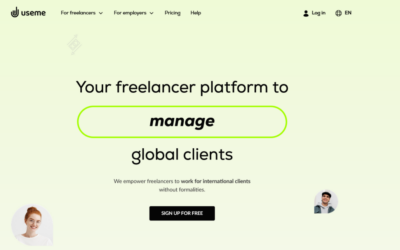Hiring employees is one of the most critical tasks you will undertake in your business. Employees are the most valuable resource and the biggest cost for any company. Today, more resources are available to help you find new employees.
However, this doesn’t necessarily make the hiring process easier. Identifying the right places to find employees for your business can be challenging.
How to find employees – practical tips
Finding the right employees is crucial for the growth and sustainability of your business. The number of platforms to post jobs and strategies to attract potential candidates has grown in today’s job market. Knowing the most effective ways to source talent can significantly enhance your recruitment efforts. Let’s check possible options.
Internal recruitment
We start our list with one of the most cost-effective approaches.
Internal recruitment allows you to find the best employees among your current staff, saving costs associated with job postings. It also avoids the time-consuming process of sorting through candidates’ resumes and curriculum vitae.
Additionally, the time it takes to onboard the employee is reduced, as they are already familiar with their coworkers, company culture, and the business’s profile.
This approach also enhances the loyalty of promoted employees and brands you as an employer who recognizes and rewards its team.
When opting for internal recruitment, focus on whether the candidate has the necessary competencies. Promoting an employee unsuitable for a new role could demotivate the team and create unnecessary frustrations.
How can you start the internal recruitment process?
Ask your employees for referrals
Happy employees can be some of your strongest brand ambassadors, so why not ask them to join an employee referral program? They can then recommend you far and wide and even share why they love working for you on social media.
What is an employee referral program?
It’s a recruitment method that motivates participating employees with rewards for each successful referral they make. It’s also a great way to find new team members who match the skills and talents of your current employees.
The most important thing to remember about referral programs is that they should not be mandatory. Here are a few incentives you can offer employees for participating:
- Gift cards or personalized gifts
- Learning and development opportunities
- Prizes such as a spa day, a fancy dinner, or access to local events
3 tips for creating a successful employee referral program
- Make it easy for employees to refer candidates. Provide a simple online form or process for submitting referrals.
- Promote your program regularly. Let your employees know about the program and the incentives you offer.
- Track your results. Measure the success of your program so you can make adjustments as needed.
Employee referral programs can be a great way to find top talent and save your company money on recruitment costs. By following these tips, you can create an effective and rewarding program for your employees.
External recruitment
In external recruitment, the search for employees takes place outside the company environment. Let’s explore specific methods to find suitable candidates.
Create a career page on your company website
Where to find employees? Before diving into job board sites, start with your website, specifically the career page. It can be a separate entire site or your company’s website subdomain. This will serve as a source of information about open positions for potential employees.
Such pages are helpful not only for filling current vacancies but also for collecting contacts for future recruitment. You can encourage job seekers to leave their resumes, even if they don’t see an offer that suits them.
Here are some key components to consider including in your career section:
- Company values and culture – clearly articulate what stands your company apart. Describe your core values and why these might resonate with potential employees.
- Employee testimonials and day-in-the-life videos – incorporate multimedia elements like videos where current employees share their experiences. And provide a realistic view of a typical day at the office. This can help potential applicants visualize themselves in your environment.
- Frequently asked questions (FAQ) – address common questions that candidates might have about the work environment, growth opportunities, and application process. This section can help clarify doubts and save time for your HR team during the recruitment process.
By effectively using these elements, your career page will inform potential candidates about job opportunities and inspire them to become part of your team.
Post on job boards
Posting job ads on job posting sites (such as Indeed and Glassdoor) is one of the simplest and most apparent methods to find employees in a specific industry.
Many of these services target a particular audience. However, there are platforms where you can post your job ad listings for any (or a broader range of) categories.
Use social media to hire employees
Many companies opt to publish job descriptions and openings on social media platforms. This approach is convenient for brands with corporate profiles and an engaged community.
In this way, they reach out to their loyal followers, among whom potential employees may be found. Therefore, it’s important to maintain corporate social media accounts, as they enhance recognition and help build an engaged community.
What if your company isn’t active on social media? You can add free job boards in groups on Facebook or LinkedIn.
If you’re recruiting for a specific position, we recommend posting your job boards in industry-specific groups.
Employment agencies
An alternative to conducting recruitment on your own is hiring employees who utilize employment agencies’ services. While it may seem the least cost-effective option, it can significantly alleviate the employer’s workload and the company’s budget.
Mainly, by collaborating with an employment agency, you delegate the tasks of recruiting new people to experienced specialists who know how to find great employees.
Many of these experts have been in the industry for years and keep track of the changes in the job market. They also have proven methods of finding employees and reaching potential candidates online and offline.
For example, many employees submit applications in person at the agency’s office. When considering the advantages of working with an agency, remember that these companies have access to a vast contact database and can reach the right people quickly.
Using the services of employment agencies involves paying a fee, but after calculations, it might be a favorable option.
If you decide to conduct recruitment independently, you’ll have to bear the costs and dedicate time to preparing job boards. Additionally, you will need to select CVs and conduct interviews.
As you can see, it takes a lot of work, so analyze both options’ pros and cons before deciding.
Look internally and network
We’ve already mentioned that employment agencies have a substantial network of contacts. Regardless of whether your network is as extensive, you can leverage this by informing friends and acquaintances about current job openings in your company.
This is a cost-effective way to reach people in the market, especially if you are looking for qualified candidates with specific skills or experience.
Friends within your network can quickly reach potential employees, which, in turn, allows you to hire not only talented but also vetted and recommended individuals.
Freelancer databases websites
It’s OK if your network is small. Platforms that connect potential clients with freelancers come to the rescue. One of these platforms is Useme.
Key benefits of using Useme for recruitment
- Flexibility in hiring – Useme allows you to hire freelancers for specific projects, giving you the flexibility to scale your workforce up or down depending on your business needs.
This is ideal for companies that experience seasonal fluctuations in demand or are working on project-based initiatives. - Cost-effective solutions – since no long-term employment contracts are involved, using Useme can be more cost-effective than traditional hiring methods.
You only pay for the work you need, which can significantly reduce overhead costs like benefits, office space, and equipment. Check out our complete guide to paying freelancers. - Streamlined process – the platform handles the contract’s legalities, simplifying recruitment. By entering into a contract for specific work or a mandate contract with the freelancer, Useme ensures that all formalities are taken care of, from the contract creation to the secure payment process. This allows you to focus on the project without worrying about administrative burdens.
- Access to a vast talent pool – Useme opens up a global market of freelancers, providing access to an extensive pool of skilled professionals across various industries.
Whether you’re looking for a graphic designer, a software developer, or a copywriter, you can find qualified candidates ready to start working immediately. - Quick response time – the nature of the platform encourages quick responses, allowing you to start projects promptly. This is crucial when project deadlines are tight, and you need to find and onboard talent swiftly.
- Quality assurance – with features like reviews and ratings, you can assess the quality of potential hires based on previous client feedback. This helps make informed hiring decisions and ensures that you engage freelancers who have proven their ability to deliver high-quality work.
How to find a freelancer at Useme
- Post a job – detail the project requirements and the specific skills you seek.
- Select freelancers – browse profiles, review candidate portfolios, and select the freelancer that best fits your project needs.
- Work execution – the freelancer completes the work as specified in the contract.
- Payment and invoice – Useme handles the transaction after completing and approving the work. You receive the work and invoice, and the freelancer gets payment through the platform.
Another option is finding a freelancer straight in the database of +100K freelancers.
How to settle a deal if you already have a freelancer:
- Invite your freelancer to settle a deal – fill in the form and send it to your freelancer.
- Wait for the subcontractor to upload the finished work to Useme.
- Pay for the work and receive a tax invoice.
By integrating Useme into your recruitment strategy, you can effectively address immediate project needs with top talent worldwide. This enhances your company’s flexibility and competitive edge in the market.
This tool is precious for small businesses looking to expand their capabilities without the overhead associated with permanent hires.
Special Q&A for you
Finding the best employees can be a difficult task. If you’ve got any questions, then we’re here to help.
Ask our team of business experts, industry specialists and lawyers – we’ll come back with the best answers.
Tips on finding a new employee
Here, we will explore four fundamental approaches that you can use to improve your recruitment process and ensure you find the best candidates for your openings.
Effective job postings
In a separate article, How to write a job description, we’ve discussed in detail what elements a job post should offer (and should not) contain.
It would help if you prepared a posting with a job description, the candidate’s requirements, and information about the company and employment conditions.
All this should be written in clear language so the candidate has no doubts about the position or job title they’re applying for.
Defined target group
Whether you’re pondering where to find employees or crafting a job offer, it’s beneficial to precede the entire recruitment process with consideration of the target group.
Where you’ll find the right employees depends on which platforms and job sites they use.
To this end, you could create a persona of the ideal candidate, considering factors such as their age, place of residence, and leisure activities.
Company image
Maintaining a positive company image benefits the organization’s hourly employees long-term. Many employees apply to a specific organization solely because of their affinity, trust in the brand, and desire to be part of the team.
Various tools can be used to build a company’s image. Engaging with your audience through corporate accounts on social media or well-developed “Careers” and “About Us” pages on your company website can be particularly effective.
Career days
If you have the means, consider organizing career days at your company. It’s an open house event where potential candidates can get acquainted with your organization and team from the inside.
Additionally, you could combine career days with guest speakers who can give presentations on specific topics, establishing your company as an expert in the industry.
Go to job fairs
Job fairs provide a unique opportunity for small businesses to interact face-to-face with potential employees and promote their brand.
Think of these events as a prime occasion for professional matchmaking, where you can connect with job seekers and determine if there’s a mutual fit.
While job fairs may require a significant initial investment, they offer a valuable platform for getting your company’s name out there and directly engaging prospective hires.
Avoid these questions during an interview
It’s essential to steer clear of specific questions during the hiring process to ensure a fair and lawful interview. Navigating the conversation correctly helps avoid legal issues and fosters a respectful environment.
When searching for qualified candidates through job boards, social media platforms, or employee referrals, remember that the questions you ask can significantly impact your ability to attract top talent and maintain your company’s reputation.
Key questions to avoid in interviews
- Personal questions – avoid questions about personal life, marital status, children, or personal beliefs unrelated to job duties or company culture.
- Age-related questions – refrain from asking about a candidate’s age directly or indirectly. This is irrelevant to their capability to perform a job unless it is a legal requirement.
- Health and disability – questions about a candidate’s health or disability are inappropriate and discriminatory unless they relate directly to job requirements that cannot be accommodated otherwise.
By focusing on a candidate’s skills and experiences and fitting them with the company culture and job requirements, you can make the interview process effective and compliant with employment laws.
This approach helps find the right employees for your business and builds a positive employer brand, which is crucial for attracting future talent.
Create a great onboarding program
After successfully recruiting new team members through job boards, social media platforms, and employee referrals, the next crucial step is integrating them into your company through a well-structured onboarding program.
Critical elements of an effective onboarding program
- Introduction to company culture – begin with a comprehensive introduction to the company’s culture, values, and expectations. This foundation helps new employees understand what makes your workplace unique.
- A clear outline of job duties – provide job descriptions and outline the available responsibilities and career development opportunities. This helps align new hires with the company’s goals from the start.
- Utilization of onboarding resources:
- Welcome packets. Give new employees all the essential information in one place.
- Detailed job descriptions. Ensure they understand their role and expectations.
- Scheduled meetings. Arrange for new hires to meet with key team members to build relationships and integrate smoothly into the team.
- Training sessions – incorporate training that focuses on the specific skills required for their roles to ensure new hires feel prepared and valued.
- Regular check-ins – have hiring managers and HR teams conduct regular check-ins to address concerns and provide support throughout the adaptation period.
If your deciding to recruit a freelancer, download our freelancer onboarding checklist.
How to find employees – summary
Launching a successful recruitment initiative involves more than just posting a job opening; it requires a strategic approach tailored to your company’s specific needs and resources.
From leveraging innovative online job boards to tapping into the power of employee referrals and social media, numerous methods exist to attract and hire qualified candidates.
The key is to align these recruitment strategies with your company’s culture, values, and the specific job duties required by the role.
Careful consideration of where and how to find employees can significantly impact the quality of your hires. Whether it’s through engaging career fairs, utilizing recruitment software, or crafting compelling job descriptions, each method offers unique advantages.
Furthermore, maintaining a positive company image and creating a supportive onboarding process is crucial for retaining top talent and ensuring they integrate successfully into your team.
You can optimize your recruitment efforts by thoroughly understanding the various avenues for finding employees – from traditional job ads on popular job boards to more targeted approaches like career centers at local colleges. This helps attract the right candidates and saves time and resources in the long run, making your hiring process more efficient and effective.
Keep in mind that there are different ways of recruiting depending on the position you are hiring for. The approach will be different, for example, when looking for an administrative assistant compared to when you want to find a project manager, photographer or copywriter.




